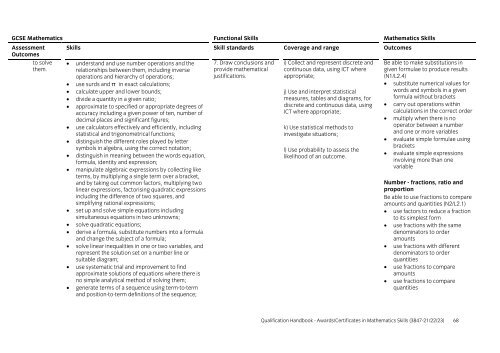Awards/certificates in mathematics skills (3847-21/22 ... - City & Guilds
Awards/certificates in mathematics skills (3847-21/22 ... - City & Guilds
Awards/certificates in mathematics skills (3847-21/22 ... - City & Guilds
You also want an ePaper? Increase the reach of your titles
YUMPU automatically turns print PDFs into web optimized ePapers that Google loves.
GCSE Mathematics Functional Skills Mathematics Skills<br />
Assessment Skills Skill standards Coverage and range Outcomes<br />
Outcomes<br />
to solve<br />
them.<br />
• understand and use number operations and the<br />
relationships between them, <strong>in</strong>clud<strong>in</strong>g <strong>in</strong>verse<br />
operations and hierarchy of operations;<br />
• use surds and π <strong>in</strong> exact calculations;<br />
• calculate upper and lower bounds;<br />
• divide a quantity <strong>in</strong> a given ratio;<br />
• approximate to specified or appropriate degrees of<br />
accuracy <strong>in</strong>clud<strong>in</strong>g a given power of ten, number of<br />
decimal places and significant figures;<br />
• use calculators effectively and efficiently, <strong>in</strong>clud<strong>in</strong>g<br />
statistical and trigonometrical functions;<br />
• dist<strong>in</strong>guish the different roles played by letter<br />
symbols <strong>in</strong> algebra, us<strong>in</strong>g the correct notation;<br />
• dist<strong>in</strong>guish <strong>in</strong> mean<strong>in</strong>g between the words equation,<br />
formula, identity and expression;<br />
• manipulate algebraic expressions by collect<strong>in</strong>g like<br />
terms, by multiply<strong>in</strong>g a s<strong>in</strong>gle term over a bracket,<br />
and by tak<strong>in</strong>g out common factors, multiply<strong>in</strong>g two<br />
l<strong>in</strong>ear expressions, factoris<strong>in</strong>g quadratic expressions<br />
<strong>in</strong>clud<strong>in</strong>g the difference of two squares, and<br />
simplify<strong>in</strong>g rational expressions;<br />
• set up and solve simple equations <strong>in</strong>clud<strong>in</strong>g<br />
simultaneous equations <strong>in</strong> two unknowns;<br />
• solve quadratic equations;<br />
• derive a formula, substitute numbers <strong>in</strong>to a formula<br />
and change the subject of a formula;<br />
• solve l<strong>in</strong>ear <strong>in</strong>equalities <strong>in</strong> one or two variables, and<br />
represent the solution set on a number l<strong>in</strong>e or<br />
suitable diagram;<br />
• use systematic trial and improvement to f<strong>in</strong>d<br />
approximate solutions of equations where there is<br />
no simple analytical method of solv<strong>in</strong>g them;<br />
• generate terms of a sequence us<strong>in</strong>g term-to-term<br />
and position-to-term def<strong>in</strong>itions of the sequence;<br />
7. Draw conclusions and<br />
provide mathematical<br />
justifications.<br />
i) Collect and represent discrete and<br />
cont<strong>in</strong>uous data, us<strong>in</strong>g ICT where<br />
appropriate;<br />
j) Use and <strong>in</strong>terpret statistical<br />
measures, tables and diagrams, for<br />
discrete and cont<strong>in</strong>uous data, us<strong>in</strong>g<br />
ICT where appropriate;<br />
k) Use statistical methods to<br />
<strong>in</strong>vestigate situations;<br />
l) Use probability to assess the<br />
likelihood of an outcome.<br />
Be able to make substitutions <strong>in</strong><br />
given formulae to produce results<br />
(N1/L2.4)<br />
• substitute numerical values for<br />
words and symbols <strong>in</strong> a given<br />
formula without brackets<br />
• carry out operations with<strong>in</strong><br />
calculations <strong>in</strong> the correct order<br />
• multiply when there is no<br />
operator between a number<br />
and one or more variables<br />
• evaluate simple formulae us<strong>in</strong>g<br />
brackets<br />
• evaluate simple expressions<br />
<strong>in</strong>volv<strong>in</strong>g more than one<br />
variable<br />
Number - fractions, ratio and<br />
proportion<br />
Be able to use fractions to compare<br />
amounts and quantities (N2/L2.1)<br />
• use factors to reduce a fraction<br />
to its simplest form<br />
• use fractions with the same<br />
denom<strong>in</strong>ators to order<br />
amounts<br />
• use fractions with different<br />
denom<strong>in</strong>ators to order<br />
quantities<br />
• use fractions to compare<br />
amounts<br />
• use fractions to compare<br />
quantities<br />
Qualification Handbook - <strong>Awards</strong>/Certificates <strong>in</strong> Mathematics Skills (<strong>3847</strong>-<strong>21</strong>/<strong>22</strong>/23) 68
















